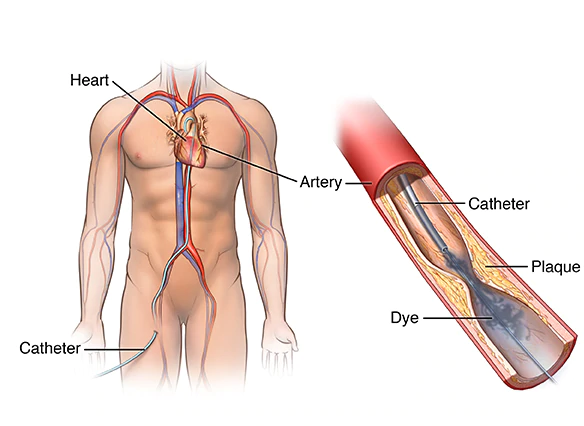Angiography
What is Angiography ?
A Coronary Angiogram is a procedure that uses X-ray imaging to see your heart’s blood vessels. Coronary angiograms are part of a general group of procedures known as heart catheterization.Heart catheterization procedures can both diagnose and treat heart and blood vessel conditions. A coronary angiogram, which can help diagnose heart conditions, is the most common type of heart catheterization procedure.
During a coronary angiogram, a type of dye that’s visible by an X-ray machine is injected into the blood vessels of your heart. The X-ray machine rapidly takes a series of images (angiograms), offering a detailed look at the inside of your blood vessels. If necessary, your doctor can perform procedures such as an angioplasty during your coronary angiogram.
What happens during Coronary Angiography?
During the procedure, a long, thin and flexible tube called a catheter is inserted into a blood vessel in your groin or arm. Using X-ray images as a guide, the tip of the catheter is passed up to the heart and coronary arteries.A special type of dye called contrast medium is injected into the catheter and X-ray images (angiograms) are taken.The contrast medium is visible on the angiograms, showing the blood vessels that the fluid travels through. This clearly highlights any blood vessels that are narrowed or blocked.The procedure is usually carried out under local anaesthetic, so you will be awake while the procedure is carried out, but the area where the catheter is inserted will be numbed.
After Coronary Angiography ?
You will usually be able to leave hospital on the same day you have a coronary angiography after a period of rest and observation. Most people feel fine a day or so after having the procedure, although you may feel a bit tired afterwards and the wound site is likely to be tender for up to a week. Any bruising may last for several weeks.
You will usually be advised to avoid certain activities, such as bathing, driving and lifting heavy objects, for a day or two after the procedure.While you are recovering, it’s important to look out for signs of any problems. You should seek immediate medical attention if swelling at the site of your wound gets worse, or if you experience excessive bleeding or circulation problems in your limbs.
